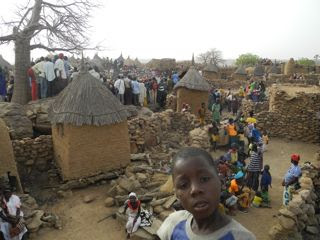
Tourists often are able to get a mask ceremony arranged at a camping site for a fee. But we had the good fortune of witnessing an authentic mass funeral mask celebration. It was part of a three week celebration and we were at the culmination of the festivities. Approximately three different villages gathered their mask dancers, who were exclusively men, to the village of Wedie. In fact, women were not allowed near the masks at all. If a group of women saw a mask approaching in the distance, they immediately ran and hid. And despite not being Dogon myself, I too was excluded from the festivities and banished to the rooftops with the other women and children. The only exception to the rule is the Sigui female who cries and chants for the masks.


















































